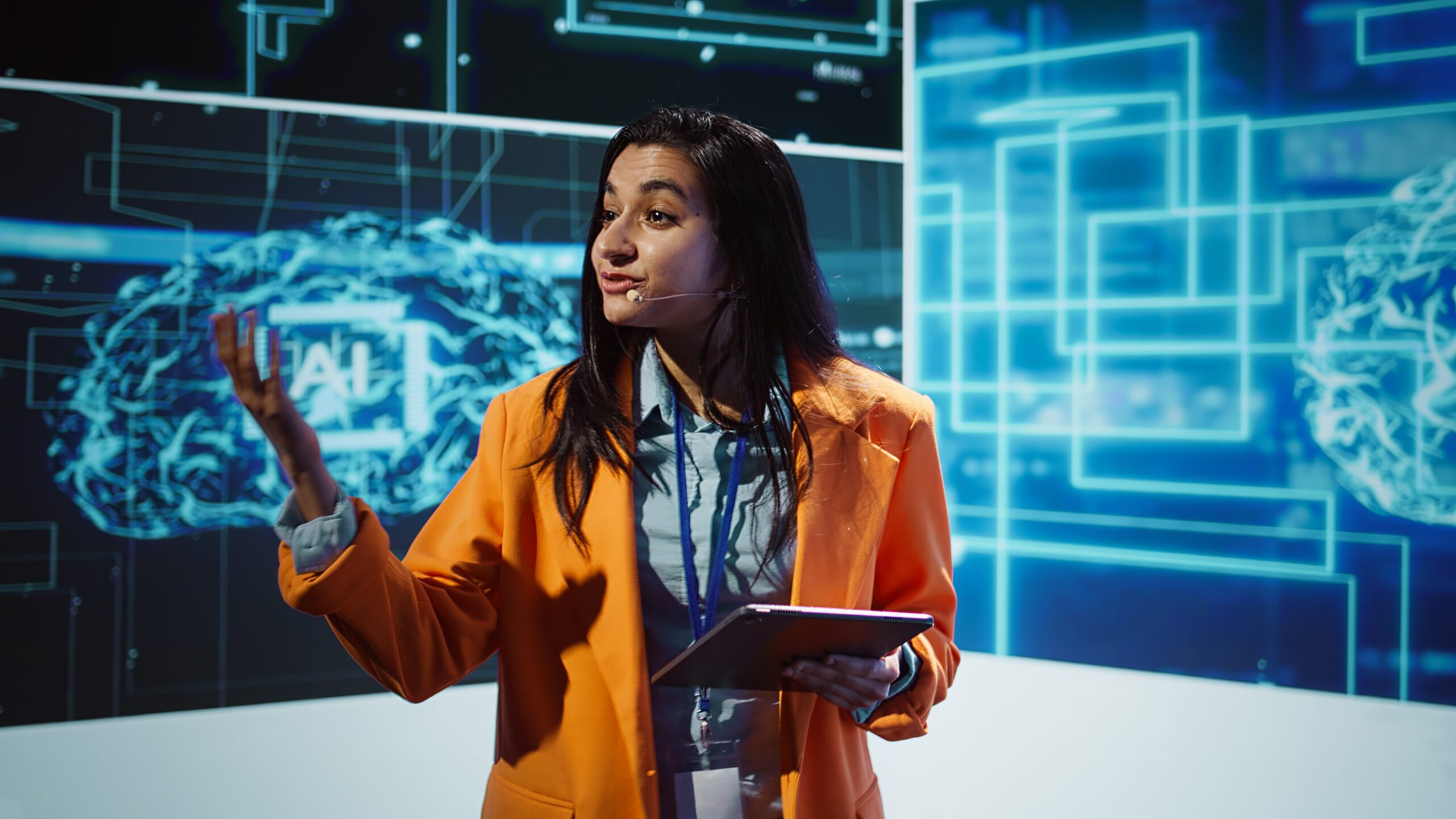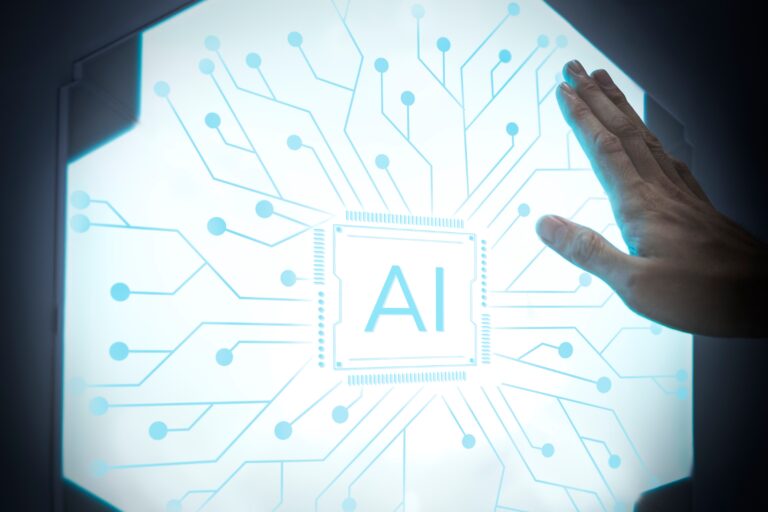
Public speaker doing presentation at tech forum event, explore ways emerging AI technologies can positively enhance companies workforce. Indian woman promoting artificial intelligence solutions
Introduction
Across Latin America, we are living through a profound transformation. Artificial Intelligence (AI) is no longer an abstract concept reserved for Silicon Valley or academic labs; it is quietly but powerfully reshaping how millions of people in our region work, learn, and earn a living. From Mexico’s manufacturing hubs to Brazil’s fintech industry, from Colombia’s customer service centers to Argentina’s creative studios, AI is redefining what work means and what it will mean in the coming decade.
For the first time in decades, technology is not just changing the tools we use—it is changing the very structure of our economies. According to the World Economic Forum, over 84% of companies in Latin America plan to invest in upskilling their workforce to keep up with the rapid integration of AI and automation. The message is clear: AI will not simply replace jobs, but it will redefine them. Yet the real question for us, as Latin Americans, is whether this revolution will close long-standing gaps—or make them wider.
A new landscape of work
From our perspective, three major forces are reshaping the world of work in Latin America. The first is automation and augmentation. Many routine and repetitive tasks are now handled by intelligent systems—from AI chatbots in customer support to predictive algorithms in logistics and agriculture. But far from eliminating human labor altogether, AI is helping workers focus on creative, interpersonal, and analytical skills—those that machines still cannot replicate.
The second is the demand for new skills. Digital literacy is no longer a luxury; it’s a basic necessity. The Inter-American Development Bank reports that more than 75% of Latin American workers will need to reskill in the next decade to remain competitive in the age of automation. This means learning not only how to use AI tools but also how to think critically, manage data, and adapt to constant change.
The third force is inequality. While cities like São Paulo, Santiago, and Monterrey are emerging as AI innovation hubs, rural and marginalized communities risk being left behind. Unequal access to education, connectivity, and capital remains one of the region’s biggest challenges. Unless we act collectively, AI could deepen the very social divides we are trying to overcome.
Opportunities for transformation
Despite these challenges, AI also presents enormous opportunities for Latin America—perhaps more than any other technological wave before it. In our experience, the greatest potential lies in the augmentation of human talent. AI is helping small businesses automate administrative work, allowing entrepreneurs to focus on innovation. It’s improving healthcare diagnostics, streamlining public services, and making agriculture more efficient through predictive weather models and smart irrigation.
A recent study by McKinsey & Company highlighted that AI could increase productivity in Central and South America by up to 20% if properly implemented. Sectors such as manufacturing, finance, and logistics could benefit the most. Beyond economics, AI can also support social inclusion—for example, enabling remote education, assisting people with disabilities, or translating indigenous languages through natural language models.
Another promising area is creativity. Latin America has a unique cultural richness that can flourish in the AI era. Artists, musicians, and designers across the region are already experimenting with generative tools to amplify their ideas. When technology meets culture, Latin America’s voice becomes stronger and more global.

The challenges we must face
Yet, as we look at this transformation from within, we also recognize its complexity. Job displacement is real. The International Labour Organization (ILO) estimates that between 2% and 5% of current jobs in the region could be fully automated, while up to 40% may undergo significant transformation. This doesn’t mean mass unemployment—it means massive adaptation. But adaptation takes time, investment, and political will.
We also face the digital divide. Millions of Latin Americans still lack stable internet access, especially in rural areas. Without infrastructure and affordable connectivity, entire communities remain excluded from digital opportunities. Furthermore, education systems across the region are struggling to keep up with the speed of technological change. AI literacy is still rare, and schools often lack the resources to train both students and teachers.
Finally, there’s the issue of ethics and governance. As AI spreads, concerns about bias, privacy, and transparency become more urgent. Latin America needs clear frameworks to regulate how algorithms make decisions that affect real people—whether in credit scoring, hiring, or access to public services. The region must ensure that AI serves the public good, not just private profit.
The role of education and policy
From our perspective, the future of work in Latin America will depend largely on how well we prepare people today. Education must evolve quickly, not only to teach technical skills but also to foster adaptability, creativity, and empathy. Schools and universities should integrate AI literacy into their curricula, helping students understand both the potential and the limitations of these technologies.
Governments, too, play a decisive role. Public policy must focus on digital inclusion, reskilling programs, and AI governance. Countries like Chile and Uruguay are already making progress through national AI strategies, investing in connectivity and education. However, a regional approach is essential. Collaboration among governments, private companies, and civil society can create shared standards and ethical frameworks that reflect Latin America’s realities and values.
A human-centered approach
As Latin Americans, we understand that technology alone does not guarantee progress—people do. The way we design, deploy, and use AI will determine whether it becomes a tool for empowerment or exclusion. From what we see, the key lies in human-centered innovation: technology that amplifies human potential, respects cultural diversity, and contributes to collective well-being.
It’s also important to remember that AI is not replacing our creativity or empathy. In fact, it reminds us of their value. Machines can predict and optimize, but they cannot dream, hope, or feel. Our role, as individuals and as a region, is to make sure that the intelligence we build reflects the humanity we wish to preserve.
Conclusion
Artificial Intelligence is redefining the future of work in Latin America—but the real story is about how we respond. If we approach this transformation with fear, we risk becoming passive consumers of foreign technologies. But if we face it with confidence, collaboration, and creativity, AI could become a catalyst for inclusion, innovation, and growth across the region.
From our point of view, the path forward must be both technological and human. We need to invest in people as much as we invest in machines. We need to teach not only how to code but how to think critically, ethically, and compassionately in a digital world. The challenge is immense—but so is the opportunity. Latin America has the talent, diversity, and resilience to turn the AI revolution into a story of empowerment.
The future of work in our region will not be decided by algorithms alone. It will be shaped by the choices we make today—by our courage to learn, to adapt, and to ensure that technology serves humanity, not the other way around.



